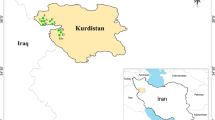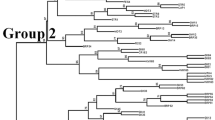Abstract
Oaks have often been the focus of research on plant evolution owing to their propensity to intercross and their important role in ecology and economy. Compared with traditional molecular markers, such as amplified fragment length polymorphisms (AFLPs) and simple sequence repeats (SSRs), multiple single-copy nuclear genes (SCNGs) are of greater utility in inferring evolutionary processes in oaks. Nineteen primer pairs were developed from expressed sequence tags (ESTs) of Quercus mongolica and Q. robur that could produce orthologous products in Chinese white oaks (section Quercus). These SCNG markers showed a moderate to high level of nucleotide polymorphism in 42 individuals of two closely related white oaks, Q. mongolica and Q. liaotungensis, and demonstrated high transferability across seven white oaks, four oaks from section Cerris, and one oak from section Lobatae. A phylogenetic tree based on these SCNGs provided resolution at deep nodes and robust support for delimiting populations of Q. mongolica and Q. liaotungensis; Bayesian analysis clustered individuals into their respective species with high probability and no admixture. When the same individuals were used, Bayesian clusters based on either 194 AFLPs or 19 SSRs gave comparable results, but one or several individuals respectively were identified as having admixed ancestry. This indicates that the hybridization rate between these two oaks may have been overestimated using SSR markers due to the occurrence of homoplasy. The SCNGs are powerful for species delimitation of white oaks, and these markers could be useful for future phylogenetics and phylogeography research in white oaks.


Similar content being viewed by others
References
Bai W-N, Zhang D-Y (2014) Current status and future directions in plant phylogeography. Chin Bull Life Sci 26:125–137
Burger WC (1975) The species concept in Quercus. Taxon:45–50
Cavender-Bares J (2016) Diversity, distribution and ecosystem services of the North American Oaks. Int Oaks 27:37–48
Curto MA, Puppo P, Ferreira D, Nogueira M, Meimberg H (2012) Development of phylogenetic markers from single-copy nuclear genes for multi locus, species level analyses in the mint family (Lamiaceae). Mol Phylogenet Evol 63(3):758–767
Denk T, Grimm GW (2010) The oaks of western Eurasia: traditional classifications and evidence from two nuclear markers. Taxon 59(2):351–366
Duarte JM, Wall PK, Edger PP, Landherr LL, Ma H, Pires JC, Leebens-Mack J, dePamphilis CW (2010) Identification of shared single copy nuclear genes in Arabidopsis, Populus, Vitis and Oryza and their phylogenetic utility across various taxonomic levels. BMC Evol Biol 10:61
Dumolin S, Demesure B, Petit R (1995) Inheritance of chloroplast and mitochondrial genomes in pedunculate oak investigated with an efficient PCR method. Theor Appl Genet 91(8):1253–1256
Eaton DAR, Hipp AL, González-Rodríguez A, Cavender-Bares J (2015) Historical introgression among the American live oaks and the comparative nature of tests for introgression. Evolution 69(10):2587–2601
Estoup A, Jarne P, Cornuet JM (2002) Homoplasy and mutation model at microsatellite loci and their consequences for population genetics analysis. Mol Ecol 11(9):1591–1604
Fu Y-X, Li W-H (1993) Statistical tests of neutrality of mutations. Genetics 133(3):693–709
Fujita MK, Leaché AD, Burbrink FT, McGuire JA, Moritz C (2012) Coalescent-based species delimitation in an integrative taxonomy. Trends Ecol Evol 27(9):480–488
Gailing O, Curtu AL (2014) Interspecific gene flow and maintenance of species integrity in oaks. Ann For Res 57(1):5–18
Govaerts R, Frodin DG (1998) World checklist and bibliography of Fagales (Betulaceae, Corylaceae, Fagaceae and Ticodendraceae). Royal Botanic Gardens, Kew
Gugger PF, Cokus SJ, Sork VL (2016) Association of transcriptome-wide sequence variation with climate gradients in valley oak (Quercus lobata). Tree Genet Genomes 12(2):1–14
Guichoux E, Garnier-Géré P, Lagache L, Lang T, Boury C, Petit RJ (2013) Outlier loci highlight the direction of introgression in oaks. Mol Ecol 22(2):450–462
Hall TA (1999) BioEdit: a user-friendly biological sequence alignment editor and analysis program for Windows 95/98/NT. Nucleic Acids Symp Ser 41:95–98
Heled J, Drummond AJ (2010) Bayesian inference of species trees from multilocus data. Mol Biol Evol 27(3):570–580
Hipp AL (2015) Should hybridization make us skeptical of the oak phylogeny? International Oak Journal 26:9–18
Hipp AL, Eaton DA, Cavender-Bares J, Fitzek E, Nipper R, Manos PS (2014) A framework phylogeny of the American oak clade based on sequenced RAD data. PLoS One 9(4):e102272
Hubert F, Grimm GW, Jousselin E, Berry V, Franc A, Kremer A (2014) Multiple nuclear genes stabilize the phylogenetic backbone of the genus Quercus. Syst Biodivers 12(4):405–423
Hudson RR, Kaplan NL (1985) Statistical properties of the number of recombination events in the history of a sample of DNA sequences. Genetics 111:147–164
Ishida TA, Hattori K, Sato H, Kimura MT (2003) Differentiation and hybridization between Quercus crispula and Q. dentata (Fagaceae): insights from morphological traits, amplified fragment length polymorphism markers, and leafminer composition. Am J Bot 90(5):769–776
Kopelman NM, Mayzel J, Jakobsson M, Rosenberg NA, Mayrose I (2015) Clumpak: a program for identifying clustering modes and packaging population structure inferences across K. Mol Ecol Resour 15(5):1179–1191
Lexer C, Kremer A, Petit R (2006) COMMENT: shared alleles in sympatric oaks: recurrent gene flow is a more parsimonious explanation than ancestral polymorphism. Mol Ecol 15(7):2007–2012
Li M, Wunder J, Bissoli G, Scarponi E, Gazzani S, Barbaro E, Saedler H, Varotto C (2008) Development of COS genes as universally amplifiable markers for phylogenetic reconstructions of closely related plant species. Cladistics 24(5):727–745
Luo R, Hipp AL, Larget B (2007) A Bayesian model of AFLP marker evolution and phylogenetic inference. Statistical applications in genetics and molecular biology 6(1): Article 11
McCormack JE, Hird SM, Zellmer AJ, Carstens BC, Brumfield RT (2013) Applications of next-generation sequencing to phylogeography and phylogenetics. Mol Phylogenet Evol 66(2):526–538
Muir G, Fleming CC, Schlötterer C (2000) Species status of hybridizing oaks. Nature (Lond) 405(6790)
Muir G, Fleming CC, Schlötterer C (2001) Three divergent rDNA clusters predate the species divergence in Quercus petraea (Matt.) Liebl. and Quercus robur L. Mol Biol Evol 18(2):112–119
Muir G, Schloetterer C (2005) Evidence for shared ancestral polymorphism rather than recurrent gene flow at microsatellite loci differentiating two hybridizing oaks (Quercus spp.) Mol Ecol 14(2):549–561
Nei M (1987) Molecular evolutionary genetics. Columbia University Press, New York
Paul S, Manos JJD, Nixon KC (1999) Phylogeny biogeography and processes of molecular differentiation in quercus subgenus quercus. Mol Phylogenet Evol 12(3):333–349
Pearse IS, Hipp AL (2009) Phylogenetic and trait similarity to a native species predict herbivory on non-native oaks. Proc Natl Acad Sci U S A 106(43):18097–18102
Petit RJ, Bodénès C, Ducousso A, Roussel G, Kremer A (2004) Hybridization as a mechanism of invasion in oaks. New Phytol 161(1):151–164
Petit RJ, Csaikl UM, Bordács S, Burg K, Coart E, Cottrell J, van Dam B, Deans JD et al (2002) Chloroplast DNA variation in European white oaks: phylogeography and patterns of diversity based on data from over 2600 populations. Forest Ecol Manag 156(1):5–26
Petit RJ, Excoffier L (2009) Gene flow and species delimitation. Trends Ecol Evol 24(7):386–393
Plomion C, Aury JM, Amselem J, Alaeitabar T, Barbe V, Belser C, Berges H, Bodenes C et al (2016) Decoding the oak genome: public release of sequence data, assembly, annotation and publication strategies. Mol Ecol Resour 16(1):254–265
Pritchard JK, Stephens M, Donnelly P (2000) Inference of population structure using multilocus genotype data. Genetics 155(2):945–959
Rambaut A, Suchard M, Xie D, Drummond A (2014) Tracer v1. 6. Available from http://beast.bio.ed. ac.uk/Tracer
Rozas J, Sánchez-DelBarrio JC, Messeguer X, Rozas R (2003) DnaSP, DNA polymorphism analyses by the coalescent and other methods. Bioinformatics 19(18):2496–2497
Salse J (2012) In silico archeogenomics unveils modern plant genome organisation, regulation and evolution. Curr Opin Plant Biol 15(2):122–130
Scotti-Saintagne C, Mariette S, Porth I, Goicoechea PG, Barreneche T, Bodénès C, Burg K, Kremer A (2004) Genome scanning for interspecific differentiation between two closely related oak species [Quercus robur L. and Q. petraea (Matt.) Liebl.] Genetics 168(3):1615–1626
Small RL, Cronn RC, Wendel JF (2004) L. A. S. JOHNSON REVIEW no. 2.. Use of nuclear genes for phylogeny reconstruction in plants. Aust Syst Bot 17(2):145–170
Song S, Liu L, Edwards SV, Wu S (2012) Resolving conflict in eutherian mammal phylogeny using phylogenomics and the multispecies coalescent model. Proc Natl Acad Sci U S A 109(37):14942–14947
Tajima F (1989) Statistical method for testing the neutral mutation hypothesis by DNA polymorphism. Genetics 123(3):585–595
Valen LV (1976) Ecological species, multispecies and oaks. Taxon:233–239
Vekemans X, Beauwens T, Lemaire M, Roldán-Ruiz I (2002) Data from amplified fragment length polymorphism (AFLP) markers show indication of size homoplasy and of a relationship between degree of homoplasy and fragment size. Mol Ecol 11(1):139–151
Watterson G (1975) On the number of segregating sites in genetical models without recombination. Theor Popul Biol 7(2):256–276
Whittemore AT, Schaal BA (1991) Interspecific gene flow in sympatric oaks. Proc Natl Acad Sci U S A 88(6):2540–2544
Zeng K, Fu Y-X, Shi S, Wu C-I (2006) Statistical tests for detecting positive selection by utilizing high-frequency variants. Genetics 174(3):1431–1439
Zeng YF, Liao WJ, Petit RJ, Zhang DY (2010) Exploring species limits in two closely related Chinese oaks. PLoS One 5(11):e15529
Zeng YF, Liao WJ, Petit RJ, Zhang DY (2011) Geographic variation in the structure of oak hybrid zones provides insights into the dynamics of speciation. Mol Ecol 20(23):4995–5011
Zeng YF, Wang WT, Liao WJ, Wang HF, Zhang DY (2015) Multiple glacial refugia for cool-temperate deciduous trees in northern East Asia: the Mongolian oak as a case study. Mol Ecol 24(22):5676–5691
Zimmer EA, Wen J (2012) Using nuclear gene data for plant phylogenetics: progress and prospects. Mol Phylogenet Evol 65(2):774–785
Acknowledgements
This work was financially supported by the National Natural Science Foundation of China (31270701, 31370398). We would like to thank Prof. Da-Yong Zhang from Beijing Normal University and Prof. Shou-Xian Li from Taiwan Normal University for their useful discussions and insightful comments in marker development and Dr. Fang Du from Beijing Forestry University for providing the sample of Q. aquifolioides and her help in marker development.
Author information
Authors and Affiliations
Corresponding authors
Additional information
Communicated by A. Kremer
Data archiving statement
All nucleotide sequences were deposited in GenBank with accession numbers KX599550-KX600473
Electronic supplementary material
ESM 1
(DOC 395 kb)
Rights and permissions
About this article
Cite this article
Chen, J., Zeng, YF., Liao, WJ. et al. A novel set of single-copy nuclear gene markers in white oak and implications for species delimitation. Tree Genetics & Genomes 13, 50 (2017). https://doi.org/10.1007/s11295-017-1130-3
Received:
Revised:
Accepted:
Published:
DOI: https://doi.org/10.1007/s11295-017-1130-3




